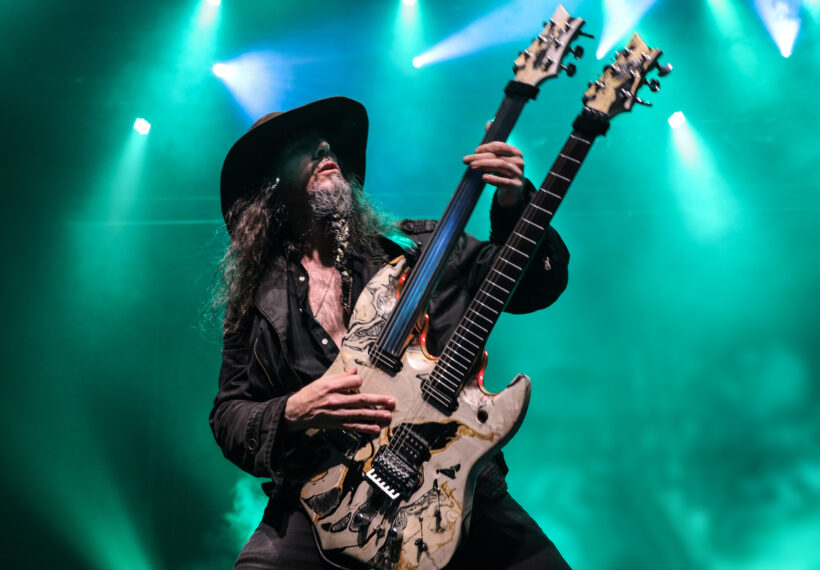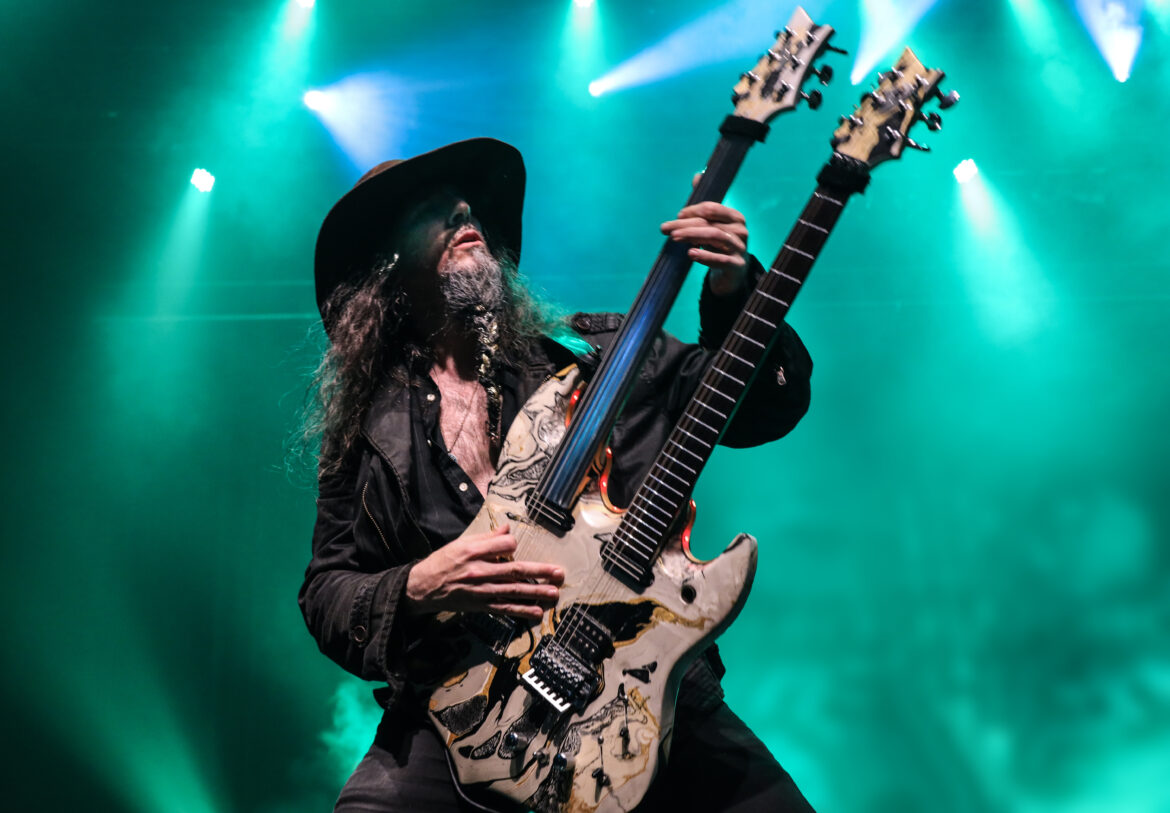
Photo: Andre Tedim
Even if you’ve never heard one of his solo records, you’ve almost certainly heard the music of guitarist Ron “Bumblefoot” Thal. Releasing his first instrumental record in 1995, The Adventures of Bumblefoot, Thal has maintained an extensive solo career while also playing with Guns N’ Roses (recording on Chinese Democracy) and various supergroups, including Art of Anarchy, Sons of Apollo and Whom Gods Destroy.
Thal returns to his instrumental roots for the first time in 30 years later this month when he releases his ninth solo album, Bumblefoot… Returns!, so Decibel caught up with the guitarist to talk shredding and the goals he still has left.
Returns! is out on January 24 via Bumblefoot’s label.
Your new album, Bumblefoot… Returns! is your first solo album in a decade. What’s changed about your approach to writing and playing music in that time?
In the past ten years there’s been lots of collaborating in bands, where I’ve been a contributing songwriter, co-writer, guitarist, producer, mixing the albums… now getting back to doing another full album of my own, the big difference I’m feeling is based on now having the guitar as the voice of the song, which allows more possibilities for the melody, more range, different tones. Singing has limits with all of that, you have just one voice, although you also have words to tell the story.
The previous album, Little Brother is Watching (2015) was all vocal songs, and having the same voice on the songs makes the overall direction feel more focused. With instrumental music, I tend to get more experimental and every song tends to have more of its own identity. And the guitar lines aren’t limited to solo sections; there’s a whole song where the guitar gets to do it all, make singable lines, experimental sounds…
Returns! features a number of pretty recognizable names in guitar, including Brian May, Steve Vai and Guthrie Govan. Did you write these songs with their parts in mind or did these collaborations arise more organically?
I originally didn’t intend to have guests, but some of the songs, once they were reaching their final form, needed a final puzzle piece that only certain people would fit. It would have felt like I was doing an imitation without those guests, and the songs needed the real deal.
I’m so grateful that each contributed so wonderfully to the songs. They gave the songs something that not only I couldn’t, but only they could. “Monstruoso” needed someone who can make the guitar sound like it’s not from this world, and that’s exactly what Steve did. “Once in Forever” was so melodic and full of harmonies, only Brian could lift the song in that way he does. Jerry Gaskill of King’s X plays drums and Derek Sherinian plays keys on that song as well.
All other drums on the album are by the great Kyle Hughes, he’s been my drummer for nearly 10 years. There’s nothing he can’t play, and he’s a great guy, as is every guest.
My old friend Guthrie, we’ve been friends since we were teenagers, since 1989, the song “Anveshana” he plays on is based on a riff I had lurking in my head since back then, and as the song came together and there was an open space perfect for trading solos back & forth, it was fitting that he be on that song. The song “Funeral March” was originally written for piano–as it developed and needed a solemn crying violin in the lead, Ben Karas, violinist of the amazing band Thank You Scientist, was the only person in mind.
Your debut album, The Adventures of Bumblefoot, came out 30 years ago and is your only other fully-instrumental album. What made you return to the style so many years later?
My pursuits from the beginning were as a singer, songwriter, guitarist, founding band member, doing our own music. I wasn’t looking to be an instrumental guitarist. I signed a record deal in the mid-’90s to do music with vocals, but they asked me to do an instrumental album to start things off. I did The Adventures of Bumblefoot album (1995), which opened the door to doing video game soundtracks, TV & film music.
After that I went back on the path, proggy, quirky hard rock with vocals, and over the decades released albums that would have some instrumental songs, but more in the way a Van Halen album would have some between the vocal songs. Since the last Bumblefoot album, I did the first Art Of Anarchy album in 2015 with Scott Weiland, another in 2017 with Scott Stapp, Sons Of Apollo’s debut that same year, the live SOA album/video in 2019, an instrumental single that year, released the next SOA album in 2020, while touring and producing bands every moment in-between, including fronting the band Asia.
Then the 2020 lockdown hit, and there was suddenly time, lots of it. I often thought ‘someday when there’s time’ I’d like to do another instrumental album like the first Adventures one, another lounge-metal album like Uncool (2002), another acoustic EP like Barefoot (2008).
During the lockdown I put out an instrumental single ‘Planetary Lockdown’, did two acoustic Barefoot 2 & 3 EPs (at bumblefoot.bandcamp.com), was busy in the studio every day mixing people’s songs & albums, laying guest solos, doing online teaching, lots of the things I had missed doing while touring so much. And then got the itch to do another fully-instrumental album, and started writing and demoing ideas… it was the gift of time that made it possible, being forced off the touring ‘hamster wheel’ and having focus and momentum being in the studio every day.
You’ve played music professionally for a long time now, and done quite a bit. Do you still have goals or ambitions that you haven’t realized?
At 55 years old, doing this nonstop since age 6, I feel like I’ve lived my life. I’m at peace with where it went, I have no expectations, and I’m doing things now not to have more of a career. I’ve actually cut down on a lot of things, I’m now doing what I enjoy most, and what serves others best. I love producing, helping others make their music come to life (producing the next Evoken album as we speak!). I love teaching, paying forward everything that was taught to me that allowed me to have a musical life, and using it to guide others. I’m touring less, doing more music camps, playing at fundraising shows, things that do something additional besides entertainment.
According to the press release, this album has been in progress since the lockdown period of the pandemic. Have these songs changed shape a lot during the last four or five years?
The album has been mixed, mastered, and ready for release since June 2023! But at that time, I was also mixing & mastering the debut Whom Gods Destroy Insanium album, as well as the Art Of Anarchy Let There Be Anarchy album, and was producing The Dodies album Dreamism. That’s ten other musicians and three labels – I wasn’t going to tell them all to wait for me to release my album.
After everybody was taken care of, I then picked up where I left off with releasing my album nearly a year later. In the songwriting process, the songs didn’t change very much, they’d start a bit loose with melody ideas and arrangement, but often the spontaneous ideas remained and Kyle would lay his drums, I’d lay my definite parts, and any remaining changes would be just tweaking the mixes.
There’s a pretty wide variety of styles on display throughout Returns. Would you consider this album a snapshot of your musical taste?
‘Snapshot’ is a great choice of words, yes! When I do a solo album, I think of every song like a photo of the time and place and frame of mind being captured, and an album is like a photo album of that time period. Not every picture will be the same look, the same scene. No rules other than to capture real moments, and hopefully when people listen they feel like they’re experiencing those moments too.


